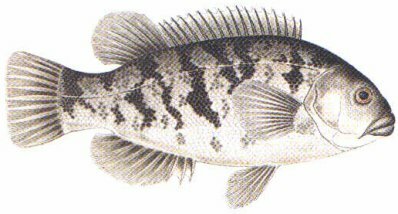|
|

 |
 |
|
Tautog are one of the first species available to anglers in the spring and one of the last ones available in the fall. This fish is hard fighting, tough on tackle and excellent on the table!
Presented here is general information of Tautog, its reproduction, habitat, food, fishing season, angling tips, handling and cooking.
-
General information:
The Tautog or ("tog") is a popular inshore gamefish that lives along the Atlantic coast from Nova Scotia to south Carolina, with the greatest number lying along inshore waters from southern Cape cod to the Deleware Capes. It does not sustain a recreational fishery north of Massachusetts. Although capable of reaching relatively larch sizes, tauton are very slow growing. The largest tautog caught with hook and line in Massachusetts was 22 pounds 9 ounces. However, the average fish caught by anglers is 6 to 10 years old and weighs 2 to 4 pounds.
-
Reproduction:
Both sexes mature at 3 to 4 years of age. The fecundity (number of eggs produced in a spawning season) of females is directly related to their size and weight. Females 12 inches long and 1 pound in weight produce about 30,000 eggs, while a female 20 inches long and 5 pounds produce about 196,000 eggs per season. In Massachusetts, Tautog reproduce from May until August, with peak spawning activity occuring in June at water temperatures of 62 to 70 degrees F. Most spawning takes place inshore in areas dominated by eelgrass beds.
-
Habitat:
Tautog, in the northern part of their range, are typically within several miles of shore in water less that 50 feet deep. More southern populations can be found father offshore. Tautog frequently follow flood tides inshore to feed and drop back to deeper waters with the following ebb tides. Tautog are found in association with cover, hovering around steep, rocky shorelines or hiding near wrecks, wharf pilings, piers, jetties, mussel and oyster beds, and boulder strewn bottoms.
-
Food:
Juvenile and adult tautog are exclusively daytime feeders, with feeding peaks at dawn and dusk. They are so inactive at night that divers can easily catch them by hand as they lie motionless on the bottom. Tautog feed upon shallow water inverterbrates such as mussels, clams, crabs, sand dollars, amphipods, shrimp, small lobsters and barnacles. Juveniles and adults living around shoreline ledges feed heavily on blue mussels; their flat grinding teet are well suited for crushing the hard shells of such animals.
-
Fishing Season:
Spring - Fall
-
Angling Tips:
Anglers are particularly successful from April through May and in early fall when tautog are concentrated in the greatest numbers along shorelines in 50 - 60 degrees. While the best fishing is centered on Cape cod, tautog can be caught all along the Massachusetts coast from Cape Ann to the South Shore. Tautog are caught either from a boat at anchor or by casting anywhere along Massachusetts' rocky shorelines. Anglers use bait such as a large piece of seaworm, whole or halved crabs (green, rock, hermits or fiddlers) and pieces of conch, snails or crqacked clams.
A rod with "backbone" is required to catch this battling fish. Most anglers choose a medium action spinning or conventional rod with 20 to 30 pound test line and use a "no hardware" 2 hook rig with a sinker tied to the bottom. It is important to stay alert after casting or lowering the bait into the water, as fish ofter hit the bait as soon as it reaches the bottom. All slack line should be taken in as soon as the bait stops sinking. Once the fish picks up the bait, let it tap once or twice, and set the hook hard, lifting the tautog away from the bottom before the line becomes entangled in rocks.
-
Handling:
Tautog should be iced immediately after capture to retain their fine flavor. If they are iced in a large cooler the melt water should be drained occasionally so the fish do not soak in warming water. If they are iced in a boat fish box, remove the fish box's drain plug.
- Cooking:
The flavor of this fish has often been likened to that of the red snapper. Traditionally, it has been considered an ideal chowder fish. Its firm, mildly flavored flesh also lends itself well to baking and broiling, when using recipes developed for species such as striped bass.
The links to the left provide current marine and local weather reports, extended local weather reports, tide charts and the U. S. Coast Guard Navigation Center, featuring GPS information, DGPS sites (which are a must for anyone with a differential GPS), LORAN-C information, Local Notice to Mariners plus a boat load of miscellaneous navigational links, my Site Map and Link List. Although most of the links to the left provide local information, my out of state visitors can also find nationwide marine and weather information.
The remaining links to the right have my Boating, Fishing, Knot Tying, Fish Fileting and Tackle Tips pages. Following those are my Search Engine pages, one with short descriptions and another in a table form, plus my Research Page. Last but not least, is my Doll House Gallery featuring the Farmhouse and The Garfield! These keep me busy in the winter.
This page is best viewed at a resolution of 800 x 600.
As you visit my pages you will notice I love animation. Feel free to copy any of the animations.
Please don't hesitate to contact me if you are having trouble locating marine, boating, fishing, tackle information or have any questions!
Email:
|
|
|
|
|
![line]() |
|
![line]() |
|

